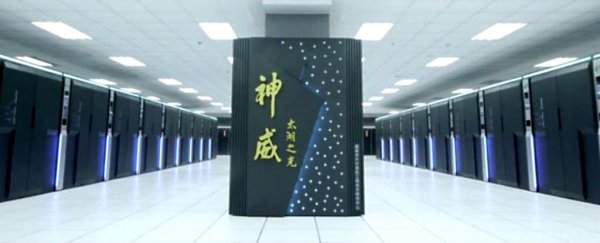If you've never heard of an exascale computer before - known unofficially as a super-supercomputer - don't worry, it doesn't even exist yet.
But 2017 could be the year that all changes, because China just announced that its world-first exascale supercomputer prototype is due for completion in the coming months. If this thing works as it should, it will be the fastest computer in the world, capable of performing 1 quintillion (a billion billion) calculations per second.
The country's National Supercomputer Centre announced this week that completion of their prototype is way ahead of schedule, and is expected to be completed in 2017, rather than 2018, as originally predicted.
It will take another couple of years before the finished prototype will be developed into a fully functional model, but if things go according to plan, it's going to be seriously worth the wait.
"A complete computing system of the exascale supercomputer and its applications can … be expected in 2020, and will be 200 times more powerful than the country's first petaflop computer Tianhe-1, recognised as the world's fastest in 2010," Zhang Ting from the National Supercomputer Centre told state news agency Xinhua.
Not content to rest on the laurels of its Tianhe-1 supercomputer, China has since developed the Tianhe-2, which in 2015 was named the most powerful computer in the world - the sixth time in row that a Chinese supercomputer topped supercomputer research group Top500's biannual charts.
More recently, China revealed its fastest new supercomputer - the Sunway TaihuLight - hit a peak performance rate of 124.5 petaflops, making it the world's first system to exceed 100 petaflops.
To give you an idea of how insane an exascale computer is, the Sunway TaihuLight is capable of quadrillions of calculations each second - that's 1,000,000,000,000,000 calculations per second.
Because quadrillion is referred to using the prefix 'peta', it's called a petascale computer, and its speeds are measured in petaflops.
China's in-development prototype - which will be named Tianhe-3 when complete - is capable of performing at least 1 quintillion calculations (or 1,000,000,000,000,000,000) per second.
Just to blow your mind further, quintillion is a number that's usually only used for explaining the mass of Earth (in tons) or the number of molecules in the human brain.
The US also has an exascale computer in the works, but doesn't expect its model to be up and running before 2023.
But according to the Department of Energy, its Exascale Computing Project will revolutionise the research industry, and I don't use that word lightly.
"At 1,000,000,000,000,000,000 calculations per second, exascale supercomputers will be able to quickly analyse massive volumes of data and more realistically simulate the complex processes and relationships behind many of the fundamental forces of the Universe," the Department of Energy says on its website.
"[E]xascale supercomputers will more realistically simulate the processes involved in precision medicine, regional climate, additive manufacturing, the conversion of plants to biofuels, the relationship between energy and water use, the unseen physics in materials discovery and design, the fundamental forces of the Universe, and much more."
With the top two supercomputers in the world currently residing in China, and a new leader reportedly on the way, the US will struggle to beat them in the coming years - it has five in the world's top 10 list, but they're many times less powerful than China's top two.
But competition spurs innovation, so it doesn't really matter who gets there first, as long as it will do great things for science.
Watch this space.
